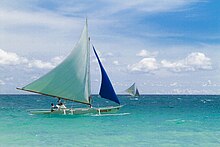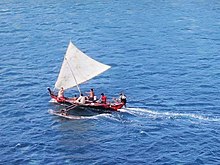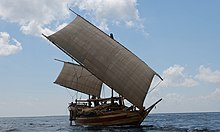Lepa (ship)

Lepa, also known as lipa or lepa-lepa, are indigenous ships of the Sama-Bajau people in the Philippines, Malaysia, and Indonesia. They were traditionally used as houseboats by the seagoing Sama Dilaut. Since most Sama have abandoned exclusive sea-living, modern lepa are instead used as fishing boats and cargo vessels.[1]
Lepa are medium-sized boats, usually averaging at 30 to 50 ft (9.1 to 15.2 m) in length, and around 5 to 7 ft (1.5 to 2.1 m) in width; with the hull averaging at 5 ft (1.5 m) in height. Very large lepa are known as kumpit. They can reach lengths of 50 to 120 ft (15 to 37 m) and are most often used as trade ships.[2] Lepa fitted with rudders instead of traditional steering oars are known as sapit (or sappit). Small one or two-person canoe-like variants of the lepa used exclusively in shallow water are known as buggoh (also boggo', buggoh jungalan or buggoh-buggoh). A buggoh is often towed by a family lepa. Lepa can also be used as a generic term for "boat" in the various Sama-Bajau groups; the vinta, for example, is also known as lepa-lepa. Lepa nowadays are increasingly being replaced by motor-powered outrigger canoes, the pambot ("pump boat").[1][3][4][5]

Description
The keel of lepa is made from a shallow dugout known as the tadas or lunas. It is built up along the sides with strakes that are narrower than the keel. An additional three sideboards are joined edge-to-edge to the topmost strake (the gunwales), extending from the stern. They are known as (bottom to top) bengkol, kapi kapi, and koyang koyang. They do not extend fully towards the prow, forming a distinctive gap at the front hull of the ship. The hull tapers sharply at the prow and stern. Like in other indigenous Philippine ships, the hull of the lepa is traditionally fitted together by dowels (tambuko) and fiber lashings instead of nails. A detachable house-like structure (the kubu or balutu) is often built in the center of the hull, with a removable decking known as lantai as the floor. The roof (sapaw) is made with plaited nipa leaves mounted on detachable Y-shaped posts. The portable cooking hearth (lappohan) is located in the stern deck, along with stored food (lutu) and water jars (kibut).[6][1][5]
Lepa has a single sail (lamak), mounted on a mast socketed into the keel through the front decking. Like the roof posts, it can be detached as needed. Lepa can also be propelled by paddles (dayung) or quant poles. Modern lepa are almost universally fitted with motor engines.[1][5]
Lepa can be differentiated from other native boats in the region in that they do not have outriggers. The prow and the stern are also made from flat carved blocks of wood, and not posts or curving planks as in vessels like the balangay. The bow (mundaˊ) and the stern (buliˊ) are low on the water to make the casting and gathering nets easier, as well as facilitate poling and rowing.[1]

Lepa are traditionally decorated with elaborate flowery designs known as okil (also spelled ukkil). The prow, especially, often features a large beautifully-carved bowsprit called the jungal.[1][7][6][5]
Traditions
In the Philippines and Malaysia, there are usually no rituals involved in the making or the launching of the lepa, probably a result of the higher level of Islamization of indigenous Sama beliefs. In eastern Indonesia however, prayers and rituals are associated with the joining of the keel with the bow and stern blocks, and the drilling of the mast post (the "navel" of the ship). After the latter, the boat is launched for the first time, and symbolically becomes the child of the boat owner.[5]
In the nomadic past of the Sama Dilaut, before a young man was to be married, his family would build or buy him a lepa, so he and his wife could live as an independent fishing unit. Upon his death, his lepa would be disassembled and served as his coffin for burial.[5]
Before undertaking long or dangerous journeys, lepa are often blessed with magic spells (haligmun) by the village shaman. These include spells that supposedly makes them invisible to pirates or deflect bullets. Sama-Bajau also sometimes make a pledge (magjanji') to God (Tuhan) or to ancestor spirits (umboh) in a crisis at sea, or when a boat fails to return home. When the boat is safe, the pledge is paid by a thanksgiving feast called the magmaulud or magbajanji.[5]
Regatta Lepa
Regatta Lepa is an annual boat festival in Semporna, Malaysia, celebrating the boat-building tradition of the Sama-Bajau communities in Sabah.[4][3]
See also
References
- ^ a b c d e f Jesusa L. Paquibot (2016). "Lepa: The Sea as Home". In Kwon Huh (ed.). Traditional Shipbuilding Techniques (PDF). Vol. 29. Intangible Cultural Heritage Courier of Asia and the Pacific, UNESCO. pp. 16–17. ISSN 2092-7959.
- ^ Maria Bernadette L. Abrera (2007). "The Soul Boat and the Boat-Soul: An Inquiry into the Indigenous "Soul"" (PDF). Philippine Social Sciences Review.
- ^ a b "The Traditional Lepa Boat". Etawau. Retrieved 7 May 2018.
- ^ a b "Regatta Lepa-Lepa". Etawau. Retrieved 7 May 2018.
- ^ a b c d e f g Clifford Sather (2001). "Bajau laut boat-building in Semporna". Traversées (35–36): 177–198.
- ^ a b "Lepa Boat". National Museum of the Philippines. Retrieved 7 May 2018.
- ^ Jun Mercado (10 November 2008). "Carvers, kumpit builders". GMA News Online. Retrieved 7 May 2018.





